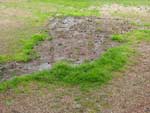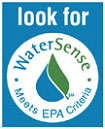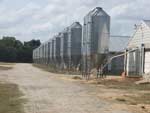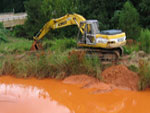Whether your drinking water comes from a lake, river, reservoir, or groundwater, it is important to protect the source from contamination. One of the best ways to protect your drinking water is to prevent pollution from getting into your drinking water source. Your drinking water can become polluted with animal waste, fertilizer, pesticides, herbicides, motor oil, gasoline, and other substances as they get carried to the source by runoff pollution .
All public water systems have identified potential sources of contamination and are working on source water protection plans. You can get involved in protecting your drinking water too by contacting your water provider.
If you have your own drinking water well, you can take steps to protect your water source. Be sure the well cover, cap, and casing are in good repair, and install a locking well cap. Keep hazardous chemicals like paint, fertilizer, pesticides, gasoline, and motor oil away from your well. Check your well each month for visible signs of cracking or corrosion. Keep the area around your well clean and free of debris. Do not pour harmful chemicals on the ground and don't overuse fertilizers and pesticides. Have your septic system checked each year, and pumped every 3-5 years. Dispose of household chemicals properly. Never pour them in your yard or down a storm drain.
Contamination of Drinking Water Sources Can Come from...

Bacteria
Leaking Septic Systems, Pet Waste, Wildlife, & Farm Animals, Improper Application of Manure
Nutrients
Fertilizers, Agriculture, Pet Waste, & Leaking Septic Systems
Chemicals
Fertilizers, Pesticides, & Household Chemicals
Trash
Paper, Plastic, Cigarette Butts, & Yard Waste
Sediment
Croplands, Forested Lands, Improperly Managed Construction Sites, & Eroding Streambanks
Motor Vehicle Fluids
Antifreeze, Battery Acid, Brake Fluids, Motor Oil & Gasoline
5 Tips To Help Protect Your Drinking Water 
Don't Dump Anything Down Storm Drains
- Storm drains lead directly to waters that may be sources of drinking water
Pick Up After Your Dog
- Pet waste contains bacteria, which can increase your risk of getting sick when ingested through swimming or other recreational activities.
- Visit DHEC's Swimming Advisory Web site for more information on swimming advisories for high use rivers, lakes, and streams.
Properly Maintain Your Car and Septic System
- Proper maintenance ensures your car or septic system will not leak and get washed into waterways.
Avoid Using More Water Than You Need 
- Water is a limited resource. As populations grow the need to have enough supply of clean water will increase, along with the costs to treat it.
- Look for the WaterSense label for high-performance, water-efficient products
Properly Dispose of Unwanted Medicine
- Don't flush or pour down a drain.
- After being flushed or poured down a drain, many medicines pass through sewer and septic systems.
- Because these systems (septic and sewer systems) can not always treat or remove the medicines, they may end up in streams, lakes, and groundwater which could be sources of drinking water.
- Learn how to properly dispose of unwanted medicine .
Additional Information & Links
- DHEC's Source Water Protection Web Site
- DHEC's Nonpoint Source Web Site
- Reining in Runoff booklet, a citizen's guide to protecting your water resources from runoff pollution
- Swimming advisories for high use recreational waters
- Beach advisories
Contacts
- Leigh Anne Flynn, (803) 898-3531




